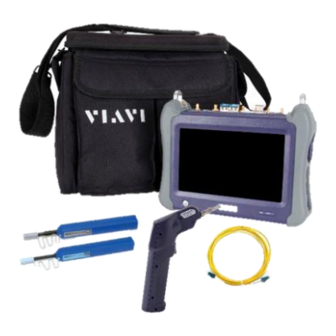
Viavi T-BERD MTS-5800 Quick Card
Network tester
Hide thumbs
Also See for T-BERD MTS-5800:
- Getting started manual (296 pages) ,
- User manual (100 pages) ,
- Quick card (6 pages)
Advertisement
Quick Card
®
T-BERD
/MTS-5800 Network Tester
Ethernet Layer 3 Multicast Traffic Generation
This document outlines how to use the T-BERD 5800 to generate IPv4 Multicast Traffic. A second T-
BERD/MTS 5800 or compatible device should be used at the far-end of the line under test to analyze
the multicast traffic and measure key performance indicators (KPIs). Multicast traffic analysis and
IGMP group membership registration is covered in a separate Quick Card.
Equipment Requirements:
• T-BERD/MTS-5800 equipped with the
following:
o BERT software release V27.2 or greater
o C510M1GE Gigabit Ethernet test option
o SFP, QSFP, or CFP4 optical transceiver
to match the line under test
• Patch Cables to match the T-BERD/MTS
optics and the line under test
• Fiber optic inspection microscope (VIAVI
P5000i or FiberChek Probe)
• Fiber Optic Cleaning supplies
The following information is required to complete the test:
• Physical Interface (10/100/1000BASE-T, 1000BASE-LX, 10GBASE-LR, 100GBASE-LR4, etc.)
• Auto Negotiation settings of the port under test
• VLAN ID, if VLAN tagging is used
• IP Address Parameters (DHCP or Static, Source IP, Default Gateway, Subnet Mask)
• Destination Multicast Group IP Address for test traffic.
• Packet size and Transmit rate for test traffic.
Fiber Inspection Guidelines:
• All fiber end-faces must be clean and pass
an inspection test prior to connection.
• Use the VIAVI P5000i, FiberChek Probe, or
Sidewinder microscope to inspect both
sides of every connection being used (SFP
Port, bulkhead connectors, patch cords,
etc.)
Figure 1: Equipment Requirements
Figure 2: Inspect Before You Connect
VIAVI Solutions
Advertisement
Table of Contents

Summary of Contents for Viavi T-BERD MTS-5800
- Page 1 Fiber Inspection Guidelines: • All fiber end-faces must be clean and pass an inspection test prior to connection. • Use the VIAVI P5000i, FiberChek Probe, or Sidewinder microscope to inspect both sides of every connection being used (SFP Port, bulkhead connectors, patch cords, etc.)
- Page 2 VIAVI Solutions Connect to Fiber Under Test (FUT): 1. For copper 10/100/1000BASE-T interface testing with the T-BERD/MTS 5800v2, connect the Port 1 10/100/1000 RJ-45 jack to the port under test using CAT 5E or better cable. 2. For copper 10/100/1000BASE-T interface...
- Page 3 VIAVI Solutions 3. If the test is not in the default settings, tap the Tools icon and select and wait for test to reconfigure. 4. Tap the Setup Soft Key to display the Interface settings tab. 5. If you are testing a 10/100/1000 Electrical or 1GigE Optical tests with auto negotiation disabled, select the Physical Layer tab and configure settings to match the Ethernet port under test.
- Page 4 Figure 8: Summary Results © 2019 VIAVI Solutions Inc. Contact Us +1 844 GO VIAVI) To reach the VIAVI office nearest you, Product specifications and descriptions in this (+1 844 468 4284) visit viavisolutions.com/contacts. document are subject to change without notice.














Need help?
Do you have a question about the T-BERD MTS-5800 and is the answer not in the manual?
Questions and answers